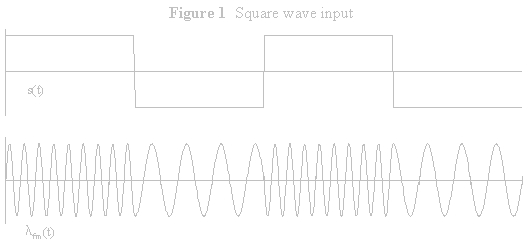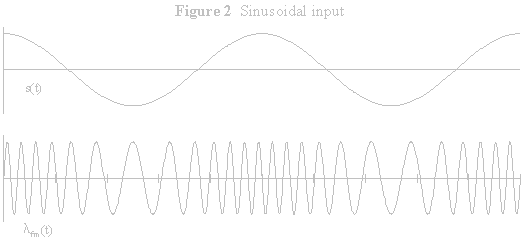

WildCat FM /technical station. Frequency Modulation Principles. 
What is the Frequency Modulation. ? Frequency modulation of a carrier signal (with frequency fC)
involves changing the frequency of this carrier based on some input signal s(t).
The modulated carrier then contains the information in s(t). This process is useful in radio
communications because it is not practical to directly transmit audio frequencies through the air.
The modulated carrier is of the form Acos [
Note that the power of
the FM signal is a constant (with value Figures 1 & 2 show some examples of frequency modulated signals and the corresponding inputs.
To examine the FM signal's
spectrum, we will look at the various harmonics comprising the input signal.
and the FM signal is
We define
as the modulation index of the FM signal. This gives us a measure of how much the frequency of the FM signal changes, ie this is a measure of the amount of modulation. Since the FM signal is periodic (for a sine wave input), we can perform a Fourier series expansion of the FM
signal to find its spectrum. This analysis yields a Bessel function of
the first kind. This tells us that the magnitude of the harmonics is eventually
decreasing (ie the function does not monotonicly decrease, but it eventually
gets smaller). In fact, the magnitude of the ( Having done this analysis (skipping the messy mathematical details), we can say that the bandwidth of the FM
signal is approximately 2( For general signals with maximum frequency deviation Phase Modulation involves changing the phase of the carrier signal based on the input g(t).
Thus, we can see that phase modulation and frequency modulation are very similar, so the analysis presented applies
to both. In fact, collectively the are described as Angle Modulation
. The concept of phase modulation will be useful in later sections.
Reference HP link
|
 (t)] , where
(t)] , where 
 A2).
A2).





 +1)th
harmonic is negligible, so we assume that there are in fact only b harmonics.
+1)th
harmonic is negligible, so we assume that there are in fact only b harmonics.
 2(kX + fm). We can thus see that the
bandwidth of the FM signal depends on the size of the frequency deviations from the carrier frequency.
Also, increasing the frequency of the input signal requires more bandwidth for transmission, which is also intuitive.
2(kX + fm). We can thus see that the
bandwidth of the FM signal depends on the size of the frequency deviations from the carrier frequency.
Also, increasing the frequency of the input signal requires more bandwidth for transmission, which is also intuitive.
 f
(ie
f
(ie  fCt+ kg(t). This is the same as frequency modulation, but with
fCt+ kg(t). This is the same as frequency modulation, but with

